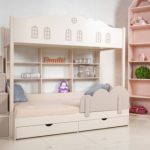Table of Contents
Age, Height, Mobility and Personal Preference
Comfortable height for a bed frame, box spring and mattress will vary from person to person. Taller people may prefer a taller bed, whereas shorter people may have difficulty getting into and out of a tall bed. Those with limited mobility may need to have a taller bed that allows their feet to reach the floor and lets them sit on the edge without having to squat deeply. Others may require a shorter bed to make it easier to reach the floor in order to prevent slips and falls. For infants, the mattress height must be set according to the height of the crib rails for safety. The top rail of a crib should be 26 inches from the bottom of a 6-inch-thick mattress for children under 35 inches tall.
Factors to Consider
There are several heights to consider when choosing a bed and bedding components. The height between the bed frame and the floor determines how much space you will have underneath the bed for storage. The height of the frame, the thickness of the mattress and thickness of the box springs add together to give the full height of the bed. Any one or all three of these components can be manipulated to adjust the bed height for comfort or to coordinate with use of other bedroom furnishings.
Types of Beds
Standard metal bed frames usually measure 7 1/2 inches, while lowboy frames measure 4 1/2 inches high. Standard box springs range from 8 to 9 inches tall, but they can be found in depths as small as 4 to 4 1/2 inches. Old fashioned beds such as Victorian or Queen Anne beds range from 5 inches to 14 inches off the floor, offering a great deal of space, but also raising the height of the combined bedding components. Because futons must serve as both couch and bed, they have a height of approximately 10 inches between floor and frame. Platform beds are low-slung, with heights varying from 4 to 18 inches from the floor.
Alternative Beds
Loft beds and bunk beds often come with adjustable frames to allow for varying mattress heights and headroom preferences. Loft beds adjust to provide headroom both above and below the sleeping platform. The typical measurement for headroom above the mattress is 30 inches, according to College Bed Lofts.com. The amount of room required will vary depending on ceiling height, mattress thickness and the height of the user. Adjustable-height beds are constructed to allow the mattress to be raised or lowered to better accommodate the user. For example, the Manual Homecare Bed may be adjusted to heights from 16 to 24 1/2 inches. Beds of this type are often used for disabled persons or those under medical care.









